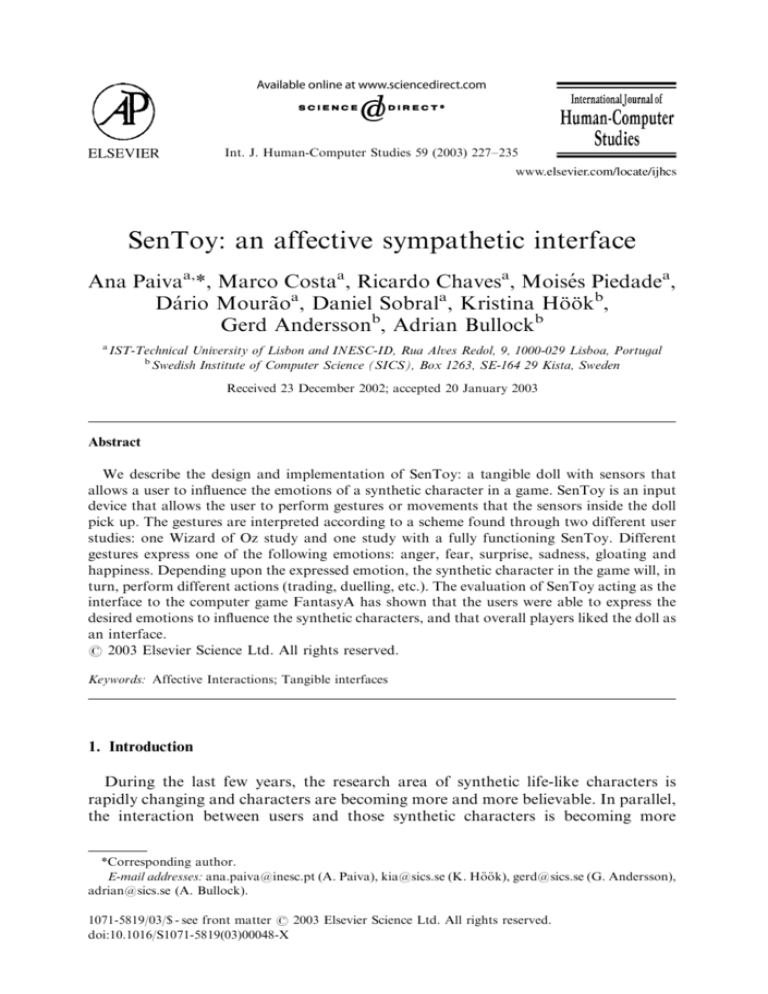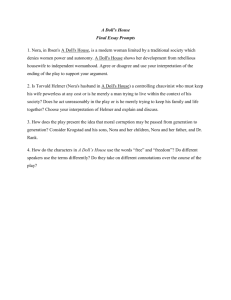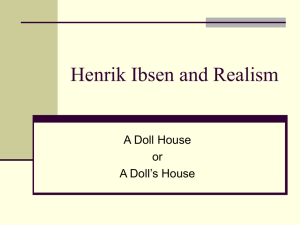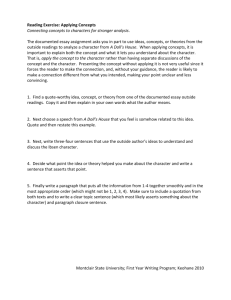
Int. J. Human-Computer Studies 59 (2003) 227–235
SenToy: an affective sympathetic interface
Ana Paivaa,*, Marco Costaa, Ricardo Chavesa, Moise! s Piedadea,
. b,
Da! rio Mour*aoa, Daniel Sobrala, Kristina Ho. ok
Gerd Anderssonb, Adrian Bullockb
a
IST-Technical University of Lisbon and INESC-ID, Rua Alves Redol, 9, 1000-029 Lisboa, Portugal
b
Swedish Institute of Computer Science (SICS), Box 1263, SE-164 29 Kista, Sweden
Received 23 December 2002; accepted 20 January 2003
Abstract
We describe the design and implementation of SenToy: a tangible doll with sensors that
allows a user to influence the emotions of a synthetic character in a game. SenToy is an input
device that allows the user to perform gestures or movements that the sensors inside the doll
pick up. The gestures are interpreted according to a scheme found through two different user
studies: one Wizard of Oz study and one study with a fully functioning SenToy. Different
gestures express one of the following emotions: anger, fear, surprise, sadness, gloating and
happiness. Depending upon the expressed emotion, the synthetic character in the game will, in
turn, perform different actions (trading, duelling, etc.). The evaluation of SenToy acting as the
interface to the computer game FantasyA has shown that the users were able to express the
desired emotions to influence the synthetic characters, and that overall players liked the doll as
an interface.
r 2003 Elsevier Science Ltd. All rights reserved.
Keywords: Affective Interactions; Tangible interfaces
1. Introduction
During the last few years, the research area of synthetic life-like characters is
rapidly changing and characters are becoming more and more believable. In parallel,
the interaction between users and those synthetic characters is becoming more
*Corresponding author.
. gerd@sics.se (G. Andersson),
E-mail addresses: ana.paiva@inesc.pt (A. Paiva), kia@sics.se (K. Ho. ok),
adrian@sics.se (A. Bullock).
1071-5819/03/$ - see front matter r 2003 Elsevier Science Ltd. All rights reserved.
doi:10.1016/S1071-5819(03)00048-X
228
A. Paiva et al. / Int. J. Human-Computer Studies 59 (2003) 227–235
natural and more inspired in the way we communicate. The Safira project was
an EU funded project aiming at building novel affective interfaces. In Safira we
have developed SenToy, a tangible interface that allows the user to influence the
emotions of his synthetic character (avatar) in a 3-D game. Sentoy is an input device
to a role playing game (FantasyA) where players must exhibit a particular set of
emotions and perform a set of actions as a way to progress in the game (see Paiva
et al., 2002). By expressing an emotion, such as for example ‘‘anger’’, the user
influences the emotional state of his controlled character, which in turn will act
accordingly in the game (for example by attacking more and more aggressively his
opponent). This will affect progress in the game. At each moment, the user must find
the appropriate emotion to control so that he can win the game. The aim of SenToy
is to ‘‘pull the user into the game’’ through the use of a physical, touchable affective
interface.
The first step in the development of SenToy was to find out if users were able to
express certain emotions through a toy-like interface. Our main questions were: can
a user control the emotional state of a synthetic character using a physical interface,
such as a doll? What kind of gestures would be the best ones to express the set of
emotional states we need for the game FantasyA? What type of doll is the most
appropriate for this kind of interface? To answer these research questions we
conducted a small Wizard of Oz study, Dahlb.ack et al. (1993). The results of this
study, Andersson et al. (2002), showed that users were able to express certain
emotions through the movements of the doll. Based on the results of this early study
we developed SenToy, which is a wireless doll that captures six emotions (happiness,
sadness, surprise, fear, gloat, anger) from the user’s gestures. SenToy was
subsequently integrated with a computer game (FantasyA) and was evaluated with
30 subjects. There was no direct coupling between the actions performed by the user
with SenToy and the behaviour of the synthetic character. Rather the synthetic
character performed emotional animations in reaction to the emotion expressed by
the SenToy. The results show that players really liked SenToy as an interface to
FantasyA and were able to influence their characters in the game with SenToy.
2. Bootstrapping the design of SenToy: wizard-of-OZ study
The design of SenToy started with a study to determine how users could express
emotions through the handling of a physical doll. Users were placed in front of a
‘‘controllable’’ synthetic character (Papous) and were asked to control the
character’s emotions through a plush toy. Fig. 1 shows the three toys that were
used. They were told that the plush toy had sensors in its arms and that they
controlled Papous, while in reality it was a human ‘‘Wizard behind the scenes’’ who
controlled Papous. When the Wizard recognized a movement pattern according to a
researched scheme (see Andersson et al., 2002 for details), she made Papous express
that emotion.
We found that different sets of movements were used more often to express the
emotions through the fake SenToy, see Table 1.
A. Paiva et al. / Int. J. Human-Computer Studies 59 (2003) 227–235
229
Fig. 1. The dolls tested.
Table 1
Results from the initial WoZ study
Emotion
Most common action
Second most common action
Anger
Fear
Disgust
Boxing with its arms
Hands in front of the eyes
Arm in front of face as if wiping
something away
Dancing/jumping, continuous
movement
Bending down its trunk
Arms in the air, frozen position
Shake the doll
Turn the doll away from the camera
‘‘Vomiting’’
Happiness
Sadness
Surprise
Arms in the air, waving them back and
forth
Hands in front of the eyes
Lifting the doll upwards into a frozen
position
We also got interesting feedback on how the doll should be designed to best fit
with the purpose. Three dolls were tested: a teddy bear, a puppet ‘‘Pippi
Longstocking’’ and a SuperModel Barbie Doll Kenneth (see Fig. 1). Users preferred
the soft and cuddly teddy bear rather than the hard plastic Kenneth. They also
preferred a doll with neutral facial expressions. The doll’s size should be about the
size of the teddy bear.
Based on these results, we developed the first prototype of the SenToy, and
integrated it into the computer game FantasyA.
3. SenToy implementation
The SenToy is an explicit sensorial interface equipped with three sets of sensors.
The first and most important is the set of accelerometers, which measure the
acceleration that the SenToy is subjected to. The movements made by the user with
SenToy, like for example bouncing the doll up and down as a dance-happiness, cause
230
A. Paiva et al. / Int. J. Human-Computer Studies 59 (2003) 227–235
variations of the acceleration value given by the accelerometer on the X-axis. These
variations are picked up and processed to determine the emotion associated with the
gesture. The second type of sensor is analog and these are used to determine the
position of SenToy’s limbs. The third set of sensors are digital, and are used to
indicate whether the hands of the doll are placed over the eyes or not. Since the
emotions/actions cannot be obtained directly from the rather complex data received
from the SenToy sensors, a signal-processing module (Stimuli Acquisition module)
was required. This module was build to capture the patterns of each of the six chosen
emotions. A significant part of the processing applied in this module is to process
and interpret data produced in the accelerometers. These signals are sent to the PC
via radio and consist on the amount of acceleration that the SenToy is subjected to in
the three spatial axes given by a set of orthogonal accelerometers and the position of
the limbs.
The emotions and actions are inferred by the characteristics of these signals,
mainly with the information given by the accelerometers, through which one can
determine the SenToy’s attitude (angle) and motion characteristics such as, the
direction of the movement and its intensity. As an example, the emotion Sad is
detected when the SenToy is bent forward (determined by the Sentoy’s attitude), and
the emotion Angry is identified when the doll is shaken (originating a fast and intense
variation in the X-axis). The position of the limbs complements the information of
the accelerometers. For example, the emotion Angry is only detected when the
SenToy is shaken with the arms up.
Concerning the look and feel of SenToy, we decided to make a soft and cuddly toy
rather than a hard plastic one, following the user’s preference in the first Wizard of
Oz study. The SenToy’s exterior was created using a soft fabric, filled with latex and
covered with a skin made with lycra-like material (see Fig. 2). A number of factors
were considered when choosing the material for the doll and the way it should be
constructed. The doll should be produced in such as way so that it can be easily
opened, providing access inside for tasks such as changing batteries and routine
maintenance. Important areas on the doll should be able to be marked with a softer
material, guiding users in the way they should feel the doll. It should have no defined
facial expression, character or personality, a result from the earlier Wizard of Oz
study. This neutral appearance should not constrain its manipulation to express
emotion, the user’s ability to identify with the doll and the adequacy of the doll to
influence different synthetic characters. Its minimalist appearance should allow for
the same toy to be used to control many different types of characters.
Given that FantasyA is like an adventure game with emotions, the image of the
toy lies between a toy and an electronic gadget. Its colour and shape reflect this idea.
4. Evaluating the realized SenToy
In the most recent study we have been able to use the working prototype SenToy
doll to test whether people understand and naturally use the actions and gestures
identified in the previous WoZ study, and also to gauge the success of the realized
A. Paiva et al. / Int. J. Human-Computer Studies 59 (2003) 227–235
231
Fig. 2. SenToy.
SenToy doll. We performed a study with 30 subjects that was divided into two parts:
first we tested the emotion gestures chosen in the WoZ study (4 additional subjects
who helped in initial game testing and configuration only undertook this first part of
the study), and second, SenToy was used to play a duel in the FantasyA game. Note
that disgust was one of the emotions in the first WoZ study, but this was
subsequently replaced with gloating. Our subjects ranged in age from 9=o 20.6=o
38 years (9=o 21.8=o 45 for the first part) and can be divided into three main
categories: Young Children, High School Students and Adults.
5. Gesturing with SenToy
Subjects were asked to express emotions, one by one, without receiving any prior
instructions. For each emotion they were given about 30 s to perform a gesture for it.
The system gave feedback through a textual display that showed which emotion
was currently recognized from their actions with SenToy. We subsequently reviewed
the video footage of each participant, noting when they successfully performed the
gesture for the requested emotion (see Fig. 3). In many cases the participants were
close, sometime extremely, to performing the gesture correctly, but the movements
232
A. Paiva et al. / Int. J. Human-Computer Studies 59 (2003) 227–235
35
30
25
20
15
10
5
0
Happy
Sad
Happy
Sad
Gloat
Anger
Fear
Surprise
35
30
25
20
15
10
5
0
Gloat
Anger
Fear
Surprise
no idea
other
alternate
correct but not recognised
correct
Fig. 3. How subjects fared in expression emotions.
were not exactly what the sensors were expecting. Alternate gestures, which had been
identified in the original WoZ study but were not yet implemented in the prototype
SenToy, were also noted.
6. Results
As we can see happiness, sadness and anger worked really well. Gloating was hard
since most pointed with the right arm, as intended, but did not simultaneously dance
A. Paiva et al. / Int. J. Human-Computer Studies 59 (2003) 227–235
233
with the doll (as in the happiness expression). Surprise was most difficult from a
sensor point of view. Subjects did pull the doll backwards, but not fast or far enough
for the sensor to pick up the acceleration. The questionnaire replies collected in this
second evaluation confirm the results. Happiness, sadness and anger are perceived as
easiest to express. Even though only half of the subjects managed to express sadness,
the other half either bent the doll’s head forward or did not apply a large enough
lean angle. We did not see a range of alternate gestures as with some of the other
emotions (e.g. fear) and so feel comfortable listing it with the obviously more
successful happiness and anger. Given the implementation of the alternate gestures
used (arm waving for happy and head movement for sad) it is fair to say that these
three emotions can be naturally and easily expressed using the doll. Further work
should concentrate on fine-tuning the amplitudes and angles of the movements
required, and not on identifying new or alternate gestures. The second group
contains gloating and fear. Our subjects were less successful at expressing these
emotions when asked, and while alternate gestures did emerge there was less of a
consensus amongst these. It is clear that pointing should be involved in the gloating
gesture, but further work is required to refine exactly what this gesture should be.
This is not totally unexpected, as gloating was not part of the previous Wizard of Oz
study, and this is the first time it is being evaluated as a gesture. Fear produced a
large range of possible gestures, and the task now is to improve the sensor alignment
and to decide upon an alternate gesture and support that well.
7. Playing FantasyA
For the second part of the study users were given instructions on how to perform
the gestures and then subsequently started to play the FantasyA game. The only
emotion that was entirely avoided was surprise. This can be due to the fact that this
emotion did not have a natural place in the game, but we suspect that it was also
because it was quite hard to perform. Gloating was used frequently with great
success.
8. Results
During the game most emotional expressions were very physical and encouraged
players to act out the emotion. Some users, especially the children, were really keen
on having the doll and would pull it from the other player or interfere and try to help
the other player in expressing some particular emotion. In the interviews, two
children commented that they would have liked to have a doll each and be able to
play against each other. Players often got very involved with the doll and the game.
Often this was expressed through bigger movements with SenToy and through voice.
Sometimes these movements would become so big so that the player would have to
lean to one side to be able to see what was happening on the screen since the SenToy
would be blocking their view. Smaller movements could be associated with less
234
A. Paiva et al. / Int. J. Human-Computer Studies 59 (2003) 227–235
12
10
8
6
4
2
0
No, it
was
hopeless
Yes,
very
much
Kids
High School
Adults
Fig. 4. Answers to the question: Did you like the doll?
involvement with the game, though sometimes this came when subjects felt more and
more assured that they knew how to express a particular emotion.
Players sometimes expressed the emotion not only through moving the doll, but
also, to some extent, through moving their own bodies. We regard this as a positive
sign that we are on the right track in creating a tangible and sympathetic interface for
affective interactions and we believe that this could probably be explored even more
in subsequent designs. After the game about 80% seemed to like the doll, see Fig. 4.
The kids were in general more enthusiastic about the doll than the adults.
9. Appearance of SenToy
Many players cuddled the doll throughout the interview (after the game). They
liked the size, compared it to a child, and seemed to enjoy its weight and design. In
the comments field of the questionnaire, one player wrote: ‘‘A few days after having
played, I still like the doll very much. I really appreciated his direct contact to give
commands, even if in that case, the commands were not that obvious and their result
a bit fuzzy.’’ (adult player)
A. Paiva et al. / Int. J. Human-Computer Studies 59 (2003) 227–235
235
One of the kids remarked that he would probably like to use the SenToy for a
whole month before getting bored. Considering that he was 12 years old, this is a
very good result!
10. Robustness of SenToy
SenToy, despite its prototype status, was able to survive 2 weeks of use with some
really rough handling from time to time. Its robustness can probably be improved,
but in general the clothing seems to work fine, the skeleton inside the doll did not
break, and most sensors survived the shaking and bending. Towards the end of the
trial phase we had some problems with sensor calibration, and the accelerometers
sometimes stopped working which in turn made the emotion surprise easier to
perform. The arm sensor for gloating sometimes failed near end the end of the trial,
but in general people managed.
11. Conclusions
In summary, we can say that SenToy was a great success. Users were able to
express the emotions that allowed them to get engaged in the game. It was robust
enough for the experiment, it encouraged a more tactile interaction, players did
identify with it and the size, shape and behaviours were close enough to what they
should be. A few improvements can be made (like adjusting the signal-processing
module to capture some of the gestures not picked up and that are easily
identifiable). SenToy works well as an input device for generating a range of gestures
that effectively express three of the basic emotions we examined.
Acknowledgements
Thanks to all our partners in the Safira project for their comments and criticisms
on the SenToy interface.
References
. K., Mour*ao, D., Paiva, A., Costa, M., 2002. Using a wizard of Oz study to inform
Andersson, G., Ho. ok,
the design of SenToy. Designing Interactive Systems (DIS). ACM Press, New York.
.
Dahlb.ack, N., Jonsson,
A., Ahrenberg, L., 1993. Wizard of oz studies—why and how. In: Proceedings
ACM International Workshop on Intelligent User Interfaces. ACM Press, New York.
. K., Mour*ao, D., Martinho, C., Costa, M., 2002. SenToy in FantasyA:
Paiva, A., Andersson, G., Ho. ok,
designing an affective sympathetic interface to a computer game. Personal and Ubiquitous Computing
Journal (Ub Comp) 6 (5–6), 2002.










